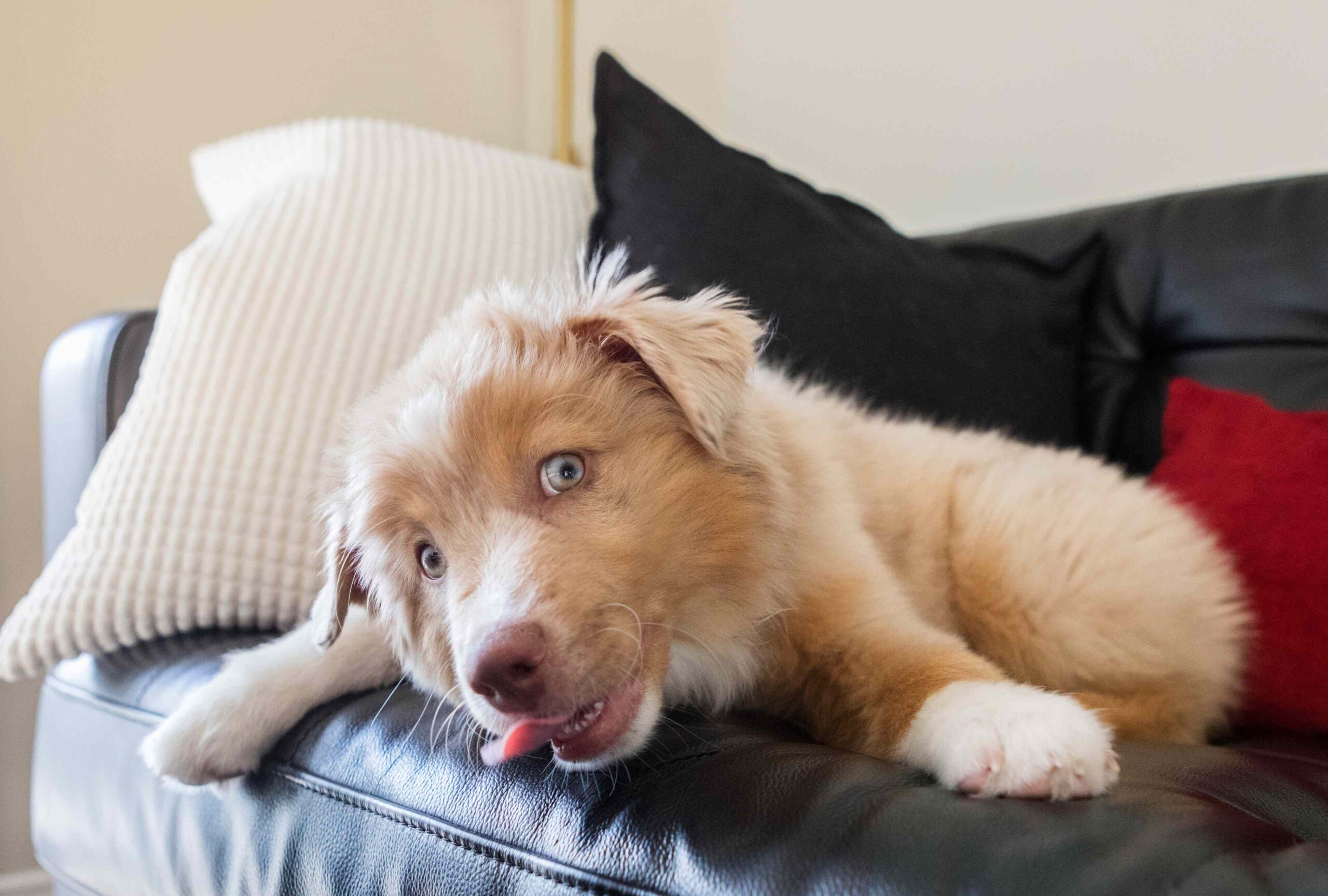:max_bytes(150000):strip_icc():format(jpeg)/spruce-pets-dog-licking-furniture-ba0f09832a9e4e5ca05bb5b0795fb2a5.png)
Dogs can be quite funny, sometimes engaging in behaviors that have us scratching our heads. If you find yourself asking why your dog is licking furniture, then you know exactly the sort of behavior we’re talking about. In many cases, a dog licking furniture is harmless, but it can be a sign of an underlying issue.
Find out the common reasons dogs lick furniture, when you should be concerned, and tactics you can use to curb the behavior.
Common Reasons Dogs Lick Furniture
Sometimes, dogs lick furniture out of curiosity, but this behavior can be a sign of a behavioral or medical issue. The following are six reasons your dog might lick furniture.
- Sensory exploration: In some cases, your dog is simply exploring their environment. Dogs learn a lot about objects through scent. If they smell something interesting on the couch, they may lick it. Your dog may also be licking the residues of other things on the couch, like crumbs that you’ve dropped.
- Boredom or lack of stimulation: Dogs who are bored or understimulated may lick the furniture. While this can tie into sensory exploration, they’re specifically licking the furniture because their other options for entertainment are limited.
- Anxiety or stress: Dogs with anxiety or stress may lick the furniture as a way of self-soothing, similar to a dog that chews excessively. This can occur with generalized anxiety or separation anxiety. Dogs with separation anxiety may become destructive, so licking furniture can turn into chewing furniture or other objects.
- Compulsive behaviors: Dogs can develop compulsive behaviors, similar to obsessive-compulsive disorder (OCD) in people. Licking, whether it’s the furniture, the floor, or even their own bodies, is an example of a behavior that can become compulsive in dogs.
- Nutritional deficiencies or GI issues: Some dogs lick when they’re feeling nauseous, so you may notice furniture licking in dogs with gastrointestinal issues. Dogs with chronic gastrointestinal problems or who are fed a low-quality diet may also develop nutritional deficiencies, which can lead to pica. The dog may lick, chew, and eat furniture and other items.
- Learned behavior or habit: Lastly, your dog may lick the furniture if you’ve reinforced this behavior over time. If you laugh and pet your dog when they’re licking the furniture, they may have learned that the behavior gets them attention.
When to Be Concerned
The occasional lick of the couch or table leg isn’t necessarily a cause for concern. However, if you’re noticing the following, you should consult with a veterinarian:
- Excessive or compulsive licking
- Swallowing pieces of furniture
- Destruction of property
- Vomiting or diarrhea
- Changes to appetite (increased or decreased)
- Lethargy
If your dog’s licking is affecting the quality of life of your dog or your family, it’s a sign that you should seek professional advice. In some cases, the veterinarian may refer you to a behaviorist.
How to Curb the Behavior
If your dog is licking the furniture so much that you need to curb the behavior, there are several techniques you can try.
- Enrichment and exercise: A bored or anxious dog is one who might develop these sorts of behavior, so increasing your dog’s mental and physical stimulation may help to reduce these behaviors. Make sure your dog is getting appropriate daily exercise and has other options for enrichment, such as chew toys or puzzle feeders.
- Training and redirection: Make sure you don’t accidentally reward your dog for licking furniture. Instead, redirect them to something that’s more appropriate to lick or chew and then reward them when they engage in appropriate behaviors. High-value treats and ample praise make great rewards for dogs.
- Environmental adjustments: In some cases, you may need to alter the pet’s environment. You can use deterrent sprays that taste bad to try to make furniture less fun for your dog to lick. You can also limit access to furniture through crate training or the use of baby gates.
- Veterinary consultation: If enrichment, training, and environmental changes aren’t changing your dog’s behavior, or if you’re seeing any of the concerning signs we’ve mentioned, it’s time to see a veterinarian. The veterinarian will rule out and address any medical problems. For some behavioral issues, they may also recommend specific medications or behavioral modification techniques.
- Behavioral support: If your veterinarian rules out medical problems and you’re not seeing improvement with training, enrichment, and environmental adjustments, you may need to consider the help of a veterinary behaviorist. Your veterinarian should be able to refer you to an appropriate specialist.
Final Thoughts on Dogs Licking Furniture
A dog licking furniture isn’t always a cause for concern, but when it’s excessive or the dog has other concerning symptoms, a veterinarian should be consulted. Pet parents should monitor their dog’s behavior and engage in proactive care.
While it can certainly be frustrating or concerning to see your dog performing a repetitive or destructive behavior, help is available from veterinarians and behaviorists to get to the root of your dog’s fascination with furniture.

